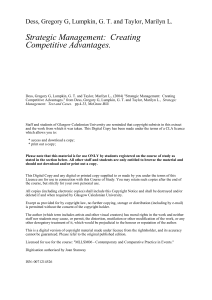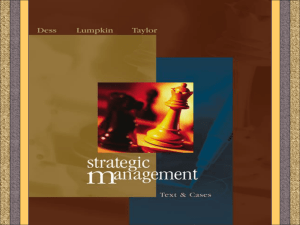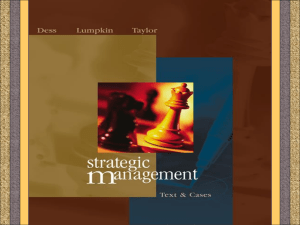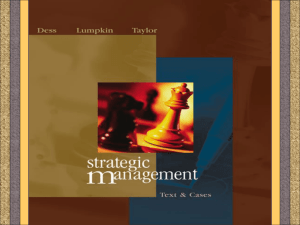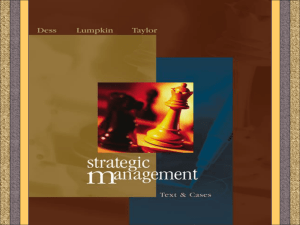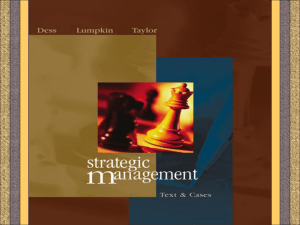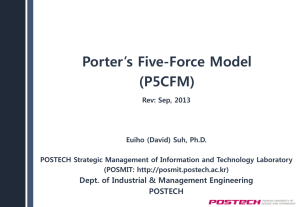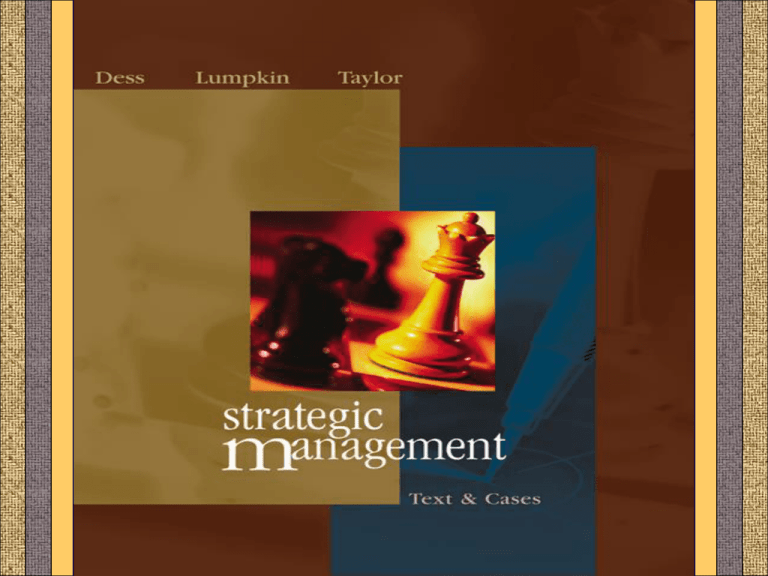
2-1
STRATEGIC MANAGEMENT
CHAPTER 2
Gregory G. Dess and G. T. Lumpkin
Chapter 2
Analyzing
the External
Environment
of the Firm
McGraw-Hill/Irwin
Copyright © 2004 by The McGraw-Hill Companies, Inc. All rights reserved.
2-3
Learning
Objectives
After studying this chapter, you should have
a good understanding of:
The importance of developing forecasts
Why environmental scanning, monitoring, and collecting
competitive intelligence are critical inputs to forecasting
Why scenario planning is a useful technique
The impact of the general environment on a firm’s strategies and
performance
How forces in the competitive environment can affect
profitability
How a firm can improve its competitive position by increasing
its power vis-à-vis forces in the competitive environment
How trends in the general environment and forces in the
competitive environment can affect performance
The concept and implications of strategic groups
STRATEGIC MANAGEMENT
CHAPTER 2
Gregory G. Dess and G. T. Lumpkin
2-4
Exhibit 2.1
Inputs to Forecasting
Environmental
Scanning
Environmental
Forecasts
Monitoring
Competitive
Intelligence
STRATEGIC MANAGEMENT
CHAPTER 2
Gregory G. Dess and G. T. Lumpkin
2-5
General Environment: Key Components
Demographic
Technological
Aging population
Genetic engineering
Changes in ethnic composition
Emergence of Internet technology
Greater income disparities
CAD/CAM
Sociocultural
Economic
More women in the workforce
Postponement of family formation
Political/Legal
Tort reform
Americans with Disabilities Act
Interest rates
Changes in stock market valuations
Global
Currency exchange rates
Emergence of the Indian and Chinese
economies
STRATEGIC MANAGEMENT
CHAPTER 2
Gregory G. Dess and G. T. Lumpkin
2-6
Exhibit 2.3
(adapted)
Impact of General Environmental
Trends on Various Industries
Segment/Trends/Events
Industry
Demographic
Aging population
Sociocultural
More women in
the workforce
Political/legal
Tort reform
Health Care
Baby products
Clothing
Baking Products
Legal Services
Auto Manufacturing
Technological
Genetic
engineering
Pharmaceutical
Publishing
Economic
Interest Rate
Increases
Residential construction
Grocery products
Global
GlobalMANAGEMENT
Trade
STRATEGIC
Positive
Shipping
CHAPTER 2
Neutral
Negative
Gregory G. Dess and G. T. Lumpkin
2-7
Exhibit 2.4
Porter’s Five Forces
Model of Industry Competition
POTENTIAL
ENTRANTS
Threat of
new entrants
Bargaining power
of suppliers
INDUSTRY
COMPETITORS
SUPPLIERS
Bargaining power
of buyers
BUYERS
Rivalry Among
Existing Firms
Threat of
substitute products
or services
SUBSTITUTES
Reprinted with the permission of The Free Press, a division of Simon & Schuster, Inc. from Competitive Strategy: Techniques for Analyzing Industries and Competitors by Michael E. Porter.
Copyright © 1980, 1998 by The Free Press.
STRATEGIC MANAGEMENT
CHAPTER 2
Gregory G. Dess and G. T. Lumpkin
2-8
Rivalry Among Competitors: Influences
•
•
•
•
•
•
Number of competitors
Industry growth rate
Fixed costs, scale issues
Lack of differentiation
Low switching costs
High exit barriers (specialized assets,
emotional commitment, restrictions)
STRATEGIC MANAGEMENT
CHAPTER 2
Gregory G. Dess and G. T. Lumpkin
2-9
Rivalry among Competitors: Outcomes
•
•
•
•
•
Using price competition and price wars
Staging advertising battles
Increasing warranties or services
Making new product introductions
Jockeying for strategic position
STRATEGIC MANAGEMENT
CHAPTER 2
Gregory G. Dess and G. T. Lumpkin
2-10
Threat of New Entrants: Entry Barriers
•
•
•
•
•
•
Economies of scale
Differentiation/brand loyalty
Capital requirements
Switching costs
Access to distribution channels
Other cost disadvantages:
– Location
– Raw materials
– Proprietary technology
STRATEGIC MANAGEMENT
CHAPTER 2
Gregory G. Dess and G. T. Lumpkin
2-11
Bargaining Power of Suppliers and
Buyers: Influences
•
•
•
•
•
•
Their size
Number
Ability to switch
Availability of substitutes
Criticality of product
Ability to vertically integrate
– Suppliers vertically integrate forward
– Buyers vertically integrate backward
STRATEGIC MANAGEMENT
CHAPTER 2
Gregory G. Dess and G. T. Lumpkin
2-12
Bargaining Power of Suppliers and
Buyers: Outcomes
• Outcomes are a function of the relative
bargaining power and dependencies of
parties
• Bargaining power is evidenced through
– Price
– Quality
– Service
STRATEGIC MANAGEMENT
CHAPTER 2
Gregory G. Dess and G. T. Lumpkin
2-13
Threat of Substitute Products
• Places an upper limit on prices
• Consists of products with a similar function
–
–
–
–
Electronic security/security guards
DSL/Cable modem
Coffee/tea/cola
Fax/overnight delivery of documents
STRATEGIC MANAGEMENT
CHAPTER 2
Gregory G. Dess and G. T. Lumpkin
2-14
Results of Industry Analysis
To one in the industry --• Unattractive industry: intense rivalry, low entry
barriers, strong suppliers and buyers, strong
product substitutes
• Attractive industry: little rivalry, high entry
barriers, weak buyers and suppliers, weak product
substitutes
STRATEGIC MANAGEMENT
CHAPTER 2
Gregory G. Dess and G. T. Lumpkin
2-15
Competitor Analysis
• What are the competitor’s capabilities
• What is the competitor currently doing and
what is the competitor capable of doing
• What are the competitor’s current and
future objectives
• What are the competitor’s beliefs about
himself, us, others, the environment
• What are the competitor’s beliefs about the
future
STRATEGIC MANAGEMENT
CHAPTER 2
Gregory G. Dess and G. T. Lumpkin
2-16
Exhibit 2.6
The World Automobile Industry:
Strategic Groups
High
Ferrari
Lamborghini
Porsche
Mercedes*
BMW
Price
Toyota
Ford
General
Motors
Chrysler*
Honda
Nissan
Hyundai
Kia
High
Low
Low
Breadth of Product Line
* Chrysler and Mercedes (part of DiamlerChrysler) are separated for purposes of illustration. Note: Members of each strategic group are only illustrative – not inclusive.
STRATEGIC MANAGEMENT
CHAPTER 2
Gregory G. Dess and G. T. Lumpkin

